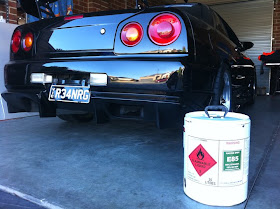Tuning with E85 nets big power!
Q & A About E85(110 octane)
Q: Why should I switch to E85?
A: E85 is a renewable fuel source that is also environmentally friendly. Its performance is comparable to race gas at a fraction of the cost. Your engine will run cooler and your ETs will be less affected by atmospheric changes. E85 is not corrosive like methanol and does not leave carbon deposits like gas so maintenance is reduced across the board. With the proper tune-up your oil stays looking like new.
Q: What is the difference in ethanol and methanol?
A: Both fuels have an excellent intake air charge cooling effect. Ethanol (grain or ethyl alcohol) is a biofuel made through the distillation of renewable resources like corn, sugar cane and switch grass. Yes, this is the same process they use to make alcoholic beverages like liquor. Fuel ethanol is 180 proof when produced. 15% regular 87 octane gasoline is added to E100 to add a little lubricant as well as ease the initial cold startup. Methanol (wood alcohol) is produced through a chemical process. By its nature methanol is more corrosive and provides 35% less energy then E85 so you have to burn 35% more of it to make comparable power. E85 cost RM15.00 a liter, Methanol cost RM10.00 a liter,VP Q16 cost RM25.00 a liter.
Q: What type of performance can I expect from making the switch to E85?
A: It has been our experience that E85 with its 105 octane rating and high tolerance to detonation is superior to premium pump gas and equal to and in most cases better than 110 octane race gas. We picked up a tenth of a second and 2 to 3 miles per hour in the eighth mile after switching to E85 from 110 race gas and our engine runs 20 degrees cooler.
Q: Don’t I have to replace all the “rubber” in my fuel system so it want be eaten up by the alcohol in E85?
A: NO!!! We started out on this journey with a complete gasoline system. We upped the flow 30% to compensate for the lower heat energy output of ethanol and left everything else the same just to see the effects. We switched to E85 at the end of the 2006 racing season and to date we have found zero deterioration or corrosion anywhere in our fuel system. We leave it in the system all the time. We don’t drain anything between races or use any type of fuel lube.
Q: How much compression can I run with E85 fuel just the way it comes out at my local?
A: This is one question I don't have a concrete answer for. We are running it in engines up to 14.5:1 naturally aspirated and some fairly high boost forced induction applications with great results. I have seen charts that draw the line at 16:1 but there again I just don’t have the data yet of a failure directly due to the compression limit of pump grade E85 being reached.
Q: Where can I find E85 in this area?
A: You can find E85 at APTuning and Email for the price.
At APTuning we are never satisfied with good enough and we love to experiment. In home of our Tuning Facility, we have a ready supply of corn juice,sugar cane E85.E85 is a blend of 85% ethanol and 15% gasoline. Originally developed as a bio-fuel for “flex fuel”, E85 has become the alternative fuel of choice for performance enthusiast. The allure of this biofuel comes from its high octane compared to regular pump fuels – 91 to 94 compared to 105 – and a very low price compared to higher octane race fuels. When compared to RM25 to RM28 a liter quality high octane race fuels E85 represents a huge bargain. If you don’t know about E85 you’re naturally asking the question “why am i not running e85 every day?”. The answer is you can’t. Most stock vehicles are not calibrated or equipped to utilize ethanol based fuels.
Despite having a higher octane rating, E85 has a lower overall energy density than pure pump fuel. Pure gasoline contains approximately 125,000 BTUs per gallon, while E85 contains approximately 84,000. This means that a greater volume of E85 must be utilized to realize the same energy content. This lower hydrocarbon content is mirrored by the stoichiometry of E85 and pure unleaded gasoline. Complete combustion of pure gasoline requires 14.7 parts air (mixed gas air with 23 percent oxygen) with one part fuel. In contrast, complete combustion of E85 requires a much higher relative content of fuel with only 9.7 parts air required. The distillation of this information means that larger volumes of E85 are required for equivalent combustion when compared to pure pump fuel. Thus, the cost savings associated with lower E85 prices is offset by an overall reduction in fuel economy.
This is really impressive for turbocharger 4G63 running E85 and pump gas. On this tune the customer swapped out the header and it appears we lost some bottom end power over the old but peak power stayed about the same (on pump gas).Runing on same boost 26psi the 97octane(1000cc)we have 450hp Dyno Dynamic.Change to E85,big injectors 1500cc,Twin Walbro pump intank and fuel trim on Haltech Platinum Sprint 500 the engine produce 532hp.Safe your engine,more power,more torque,more boost and more ignitinion timing goes up.
 |
| 4G63 turbo E85 |
 |
| 4G63 turbo engine E85 Drag 4G63 |


No comments:
Post a Comment